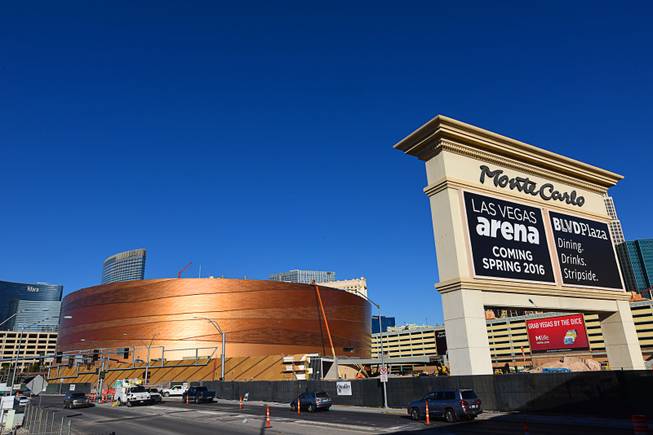
Spencer Burton
Work continues on the Las Vegas Arena on Monday, Dec. 28, 2015.
Sunday, Jan. 17, 2016 | 11:32 a.m.
Related Content
- How does Southern Nevada pay for a new mass transit system?
- Light rail: The future of transportation in Las Vegas?
- How does a plan like this come to be? Who is responsible
- Rail projects in other cities: How’d they do it?
- Getting Southern Nevada’s future on the right track
- How mass transit will affect Southern Nevada business
- How mass transit will affect Southern Nevada tourism
- How mass transit will affect Southern Nevada tourism
- How mass transit will affect downtown Las Vegas
- How mass transit will affect North Las Vegas
- How mass transit will affect sports in Southern Nevada
- How mass transit will affect Southern Nevada’s people and lifestyle
- A local’s take: The evolution of transportation in Las Vegas
- Editorial: Why Southern Nevada needs mass transit
- The Sun's light rail coverage
A look into the future of sports: Hockey fans dressed in black and gold chant, “Let’s go, Black Knights, Let’s go, Black Knights,” as the light rail car they’re packed into races toward the Strip. Crowds of tourists and locals file out of the transit station and make the short walk to the T-Mobile Arena for a night of National Hockey League action. There are families catching their first game of the season, community groups celebrating with an outing and tourists who decided last-minute to take in a game. Street vendors line the sidewalks selling nonlicensed merchandise, and ticket scalpers are out in full force. The game doesn’t start until 7 p.m., but the party already has begun. Fans passionate about cheering on the home team strike up conversations about the night’s matchup. They complain about the coaching, argue about the lineup and remain optimistic for a win. All make it to and from the arena quickly and safely.
T-Mobile Arena
In Chicago, the Red Line train leaves Cubs fans within steps of Wrigley Field. In Washington, D.C., the Metrorail stops a block away from Nationals Park. The rail systems offer more than just an organized way to bring people to the stadiums. The trains are part of the fan experience. Game-day hype starts in the transit cars.
With the upcoming opening of the T-Mobile Arena behind New York-New York, and other future arena projects at UNLV or Symphony Park a distinct possibility, Las Vegas’ best bet for moving fans to and from events — including UFC fights, hockey games and concerts — is light rail.
Fans in other cities already are intimately familiar with commuting on game day. It’s part of their DNA. And it easily can be a part of ours, too.
Hockey
Las Vegas is on the verge of landing an NHL expansion team, the city’s first major league franchise. The team would play at the privately funded, $375 million T-Mobile Arena on the Strip. The general consensus from locals is excitement — with one concern. How will fans navigate arena traffic on game nights? And where will they park?
Light rail is a necessity for hockey — or any professional sport — to survive here. It would give Las Vegans a painless way to get to and from the arena. Without it, it’s virtually impossible to bring 18,000 people in during rush hour — or any other hour, for that matter.
Most major sports franchises encourage fans to use public transportation, posting travel pointers and information about which exits to take online. They understand the simple formula: If you are stuck in traffic, you don’t enjoy the game-day experience. And if you don’t enjoy the experience, you won’t come back.
Racing
There’s no easy way to get to the Las Vegas Motor Speedway on NASCAR Sundays. Either you wait in traffic on Interstate 15 or Las Vegas Boulevard, or pay to park an RV at the speedway overnight to avoid race-day traffic altogether.
Now imagine taking light rail and disembarking hassle-free a few miles from the speedway, then hopping into a shuttle bus, taxi or Lyft car to complete your journey. It’s an organized, safe and cost-effective solution.
Las Vegas needs to take a page from the playbook of the Auto Club Speedway in Fontana, Calif., near Los Angeles. The track encourages fans to use the city’s Metrolink to travel to the track, and the ride is free on race days. Thousands of fans use the system.
The rodeo
The National Finals Rodeo at the Thomas & Mack Center sells out most nights, bringing 100,000 people to Las Vegas and pumping millions into the economy. But getting those people from the Strip, where they typically stay and spend their money, a few miles east on Tropicana Avenue to UNLV is easier said than done. Rodeo traffic going in and out of the arena can test anyone’s patience.
With a rail system, fans wouldn’t need cars. They simply could leave their hotel rooms, hop on a train and enjoy the ride to the arena. Without having to worry about drinking and driving, and with extra time saved by avoiding traffic, the cowboys could throw back a few extra drinks, stop in a restaurant or take in a show.
Light rail also would ease congestion for fans heading to UNLV basketball games. A scenic ride in a train car would be far more cost-effective and relaxing than battling traffic on the I-15 for a 7 p.m. Rebel start.
Ray Brewer can be reached at 702-990-2662 or [email protected]. Follow Ray on Twitter at twitter.com/raybrewer21

Join the Discussion:
Check this out for a full explanation of our conversion to the LiveFyre commenting system and instructions on how to sign up for an account.
Full comments policy